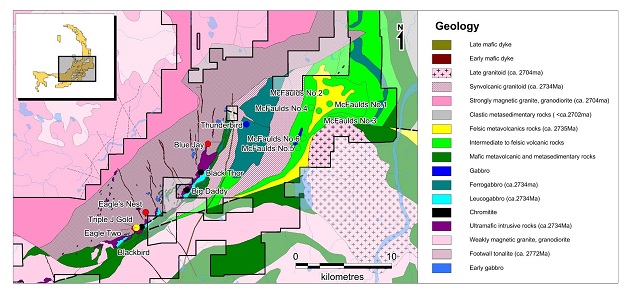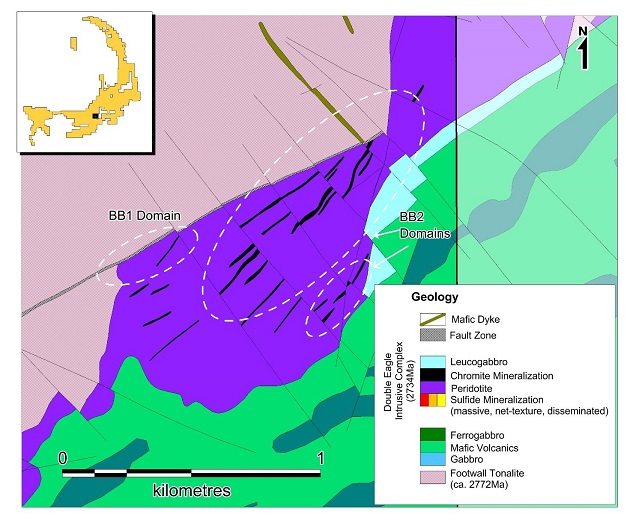Noront Resources Ltd.
Blackbird Chromite Deposit

Overview
The Blackbird chromite deposit was discovered in 2008 and will be the second mine in Noront’s pipeline. It is one of a number of large tonnage, high-quality chromite discoveries in the Ring of Fire. It offers significant potential due to its size, grade and location (less than 1 km from Eagle’s Nest).
Deposit Geology & Mineralization
Regionally the Blackbird deposit is associated with an ultramafic sill complex situated at the contact between a large tonalite body to the northwest, and an overlying volcanic sequence to the southeast (figure 1). At over 16km in strike length and up to 1.5km in thickness, this sill complex is believed to consist of at least two individual sills known as the Double Eagle Intrusive Complex and the Black Thor Intrusive Complex. Both contain an ultramafic keel and/or feeder dyke with attendant Ni-Cu-PGE mineralization, overlain by crudely layered accumulations of dunite, peridotite and chromitite and capped by pyroxenite and leucogabbro.

FIGURE 1- REGIONAL GEOLOGY OF THE SOUTHERN ROF
The Double Eagle Complex hosts the Eagle’s Nest Ni-Cu-PGE deposit, the Blackbird chromite deposit, the Eagle Two nickel occurrence and the Triple-J gold zone. The chromite deposits in the ROF are globally quite rare and geologically most similar to the Kemi chromite mine in northern Finland, currently operated by Outokumpu.

FIGURE 2- BLACKBIRD GEOLOGY MAP
The Blackbird deposit is a magmatic chromite deposit hosted within a structurally dismembered and overturned layered ultramafic sill-like body (figure 2). Coarse layering in the host ultramafic sill progresses from basal dunite and peridotite units upward into chromite mineralized dunite and peridotite into altered pyroxenite and finally a capping gabbroic unit. Ultramafic protoliths have all undergone varying degrees of serpentinization and talc-chlorite alteration. The deposit is made up of a series of discrete, sub-vertically dipping lenses of chromite mineralization which locally reach true thicknesses of up to 32m. The current resource consists of two principle domains, Blackbird 1 and Blackbird 2. Blackbird 2 comprises the bulk of the current resource and consists of five discrete chromite lenses averaging between 7-11m in true thickness. Chromite mineralization varies from thick massive lenses to thinly laminated beds to semi-massive and heavily disseminated stratiform zones.
Project Details
An updated Blackbird chromite NI-43-101 resource estimate, completed in March 2012, tripled the previous 2009 estimate and showed a 44 Mt resource with grades in excess of 35% Cr2O3, and chrome-to-iron ratios of approximately 2.0. In addition, the chromite mineralization at Blackbird remains open along strike and at depth.
Initial metallurgical test results indicate that a marketable high-grade chromite concentrate product with grades in excess of 50% Cr2O3, recoveries greater than 80%, and chrome-to-iron ratios greater 2.1 could be produced at Blackbird.
Project Status
Blackbird may be suitable for underground bulk mining techniques and could share above and below ground infrastructure with Eagle’s Nest. It provides an opportunity for Noront to supply the global ferrochrome market.
Our goal is to produce a strategic plan and a comprehensive preliminary economic analysis (PEA) for all of the development options for the Ring of Fire chromite projects.
Current resources are presented in the Table below.

Please see the report titled “NI 43-101 Technical Report Feasibility Study McFaulds Lake Property Eagle’s Nest Project James Bay Lowlands Ontario, Canada,” dated October 19th, 2012 (with an effective date of September 4, 2012) (the “Technical Report”) for details regarding the mineral reserve estimate above (section 15.1) and the mineral resource estimate above (14.2). Sections 14.2 and 15.1 of the Technical Report include a descirption of the key assumptions, parameters, and methods used to estimate the mineral resources and mineral reserves respectively. A copy of the Technical Report may be accessed under Noront’s company profile on SEDAR at www.sedar.com. Mineral resources that are not mineral reserves do not have demonstrated economic viability. The estimate of mineral resources may be materially affected by environmental, permitting, legal, title, socio-political, marketing or other relevant issues.
Source: https://norontresources.com/projects/blackbird-deposit/
